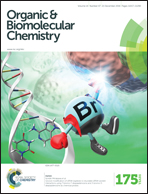Mechanistic implications of the enantioselective addition of alkylzinc reagents to aldehydes catalyzed by nickel complexes with α-amino amide ligands†
Abstract
The enantioselective alkylation of aldehydes catalysed by nickel(II)-complexes derived from α-amino amides was studied by means of density functional theory (DFT) and ONIOM (B3LYP:UFF) calculations. A mechanism was proposed in order to investigate the origin of enantioselectivity. The chirality-determining step for the alkylation was the formation of the intermediate complexes with the involvement of a 5/4/4-fused tricyclic transition state. The predominant products predicted theoretically were of (S)-configuration, in good agreement with experimental observations. The scope of the reaction was examined and high yields and enantioselectivities were observed for the enantioselective addition of Et2Zn and Me2Zn to aromatic and aliphatic aldehydes.



 Please wait while we load your content...
Please wait while we load your content...